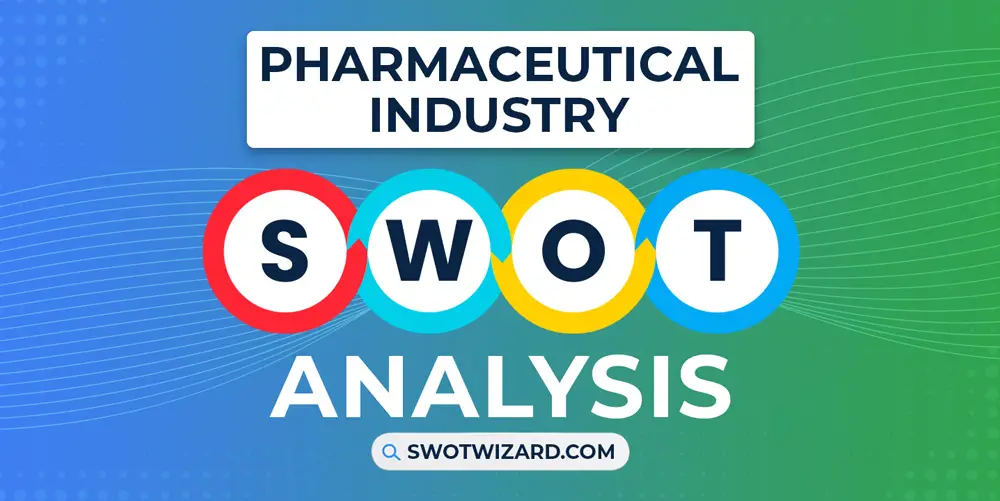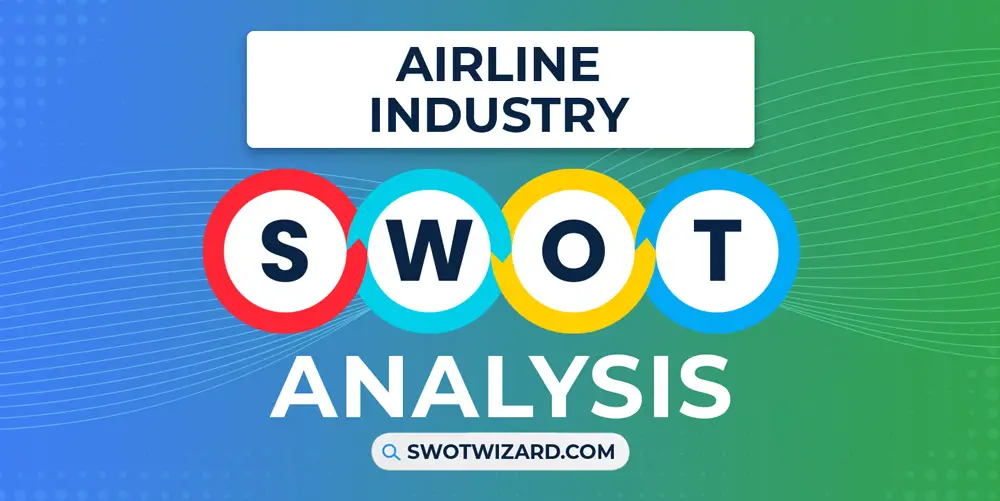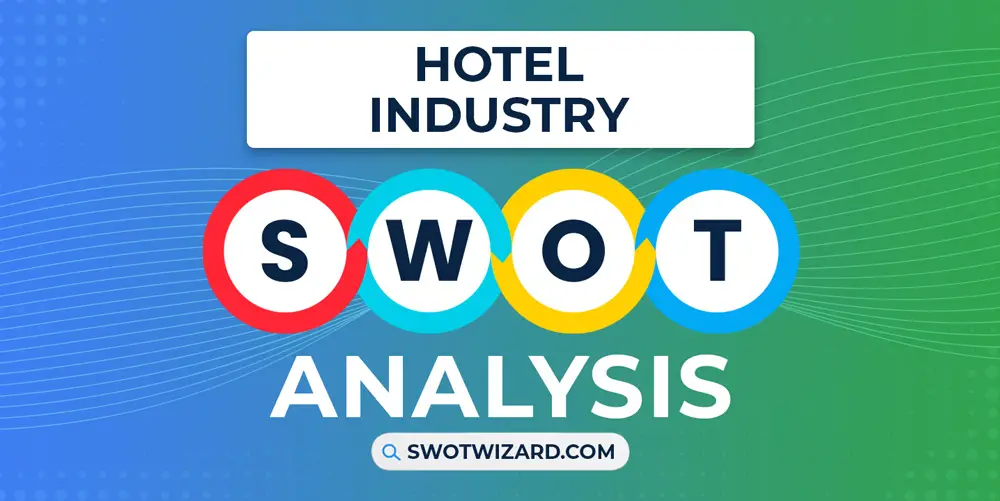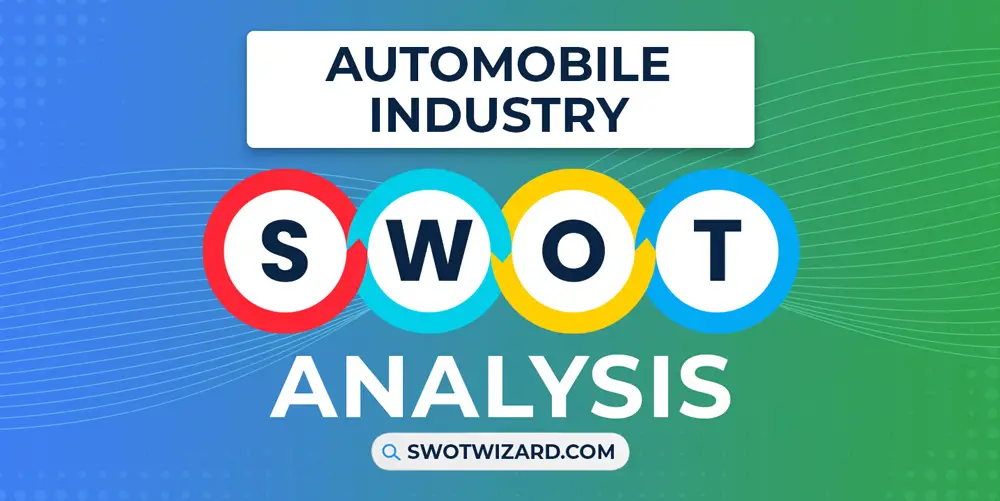Whether the first breath or the last, a human being has been served by hundreds of medicines or products produced by the pharmaceutical industry. Every innovation belongs to this industry, from using a medical scissor to cut an infant’s umbilical cord to using an oxygen tank to help breathe a dying man.
The industry has gone through many ups and downs, innovations to disrupt the market and other changes that changed the entire course of history with many strengths, weaknesses, opportunities and threats, which we will get to know in this pharmaceutical industry swot analysis.
Pharmaceutical Industry Overview
If we look at the history, it will take us back to the 1800 century and the first decade when the modern pharmaceutical industry started developing local apothecaries. Now there is almost no single disease that this industry doesn’t make.
In 2022, the total revenue of the entire industry was $1587 B, making it one of the biggest industries by revenue, with more than five million employees in this industry.
With $1.42 T of market size, the industry is growing exponentially.
Competitors in Pharmaceutical Industry
Pfizer | AbbVie | Novartis | Johnson and Johnson | Roche | BMS | Merck & Co. | Sanofi | AstraZeneca | GSK
Did You Know?
Just after the modern pharmaceutical industry started its journey, a guy named Louis Dufilho opened the first pharma store in 1816. The store offered legal and prescribed medicines, but also illegal drugs such as opium, etc.
Strengths – Pharmaceutical Industry SWOT Analysis
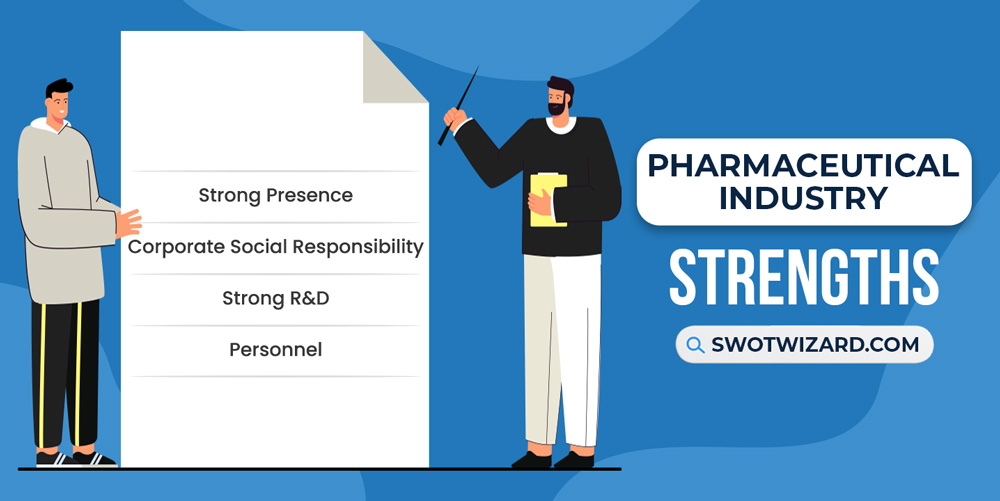
Strong Presence: There are hardly any countries where at least one pharmaceutical company hasn’t set foot. A developing center or a research institute, or a manufacturing center, every country is somehow related to this particular industry. As a result, the growth has increased to 5.39% and will continue to grow. And it is estimated that it will become a $1,435 B industry by 2027.
Corporate Social Responsibility: Corporate social responsibility goes a long way for companies, and every company is doing their CSR program to build a reputation and better brand recognition. Because of that, we can see the positive impacts of CSR in this industry. Besides, pharma companies are building better systems to help customers with various initiatives to improve the experience.
Strong R&D: The entire Pharma industry depends on the R&D wing to bring innovative, more effective, efficient medicines. As we can see in the data, on average, they spent more than $2 B for effective drugs for 14 years, and in 2021 alone, the total cost behind R&D was nearly $50 B. And it took Pfizer more than $5 B to develop the Covid vaccine, thanks to the advanced R&D sector.
Personnel: From researchers to other personnel related to the pharma industry, the personnel count is relatively huge compared to other sectors. As a result, we can see this industry’s growth and employment rate is increasing, and currently, more than five million people are employed globally. And by this decade’s end, the industry will grow, and so the personnel.
Weaknesses – Pharmaceutical Industry SWOT Analysis
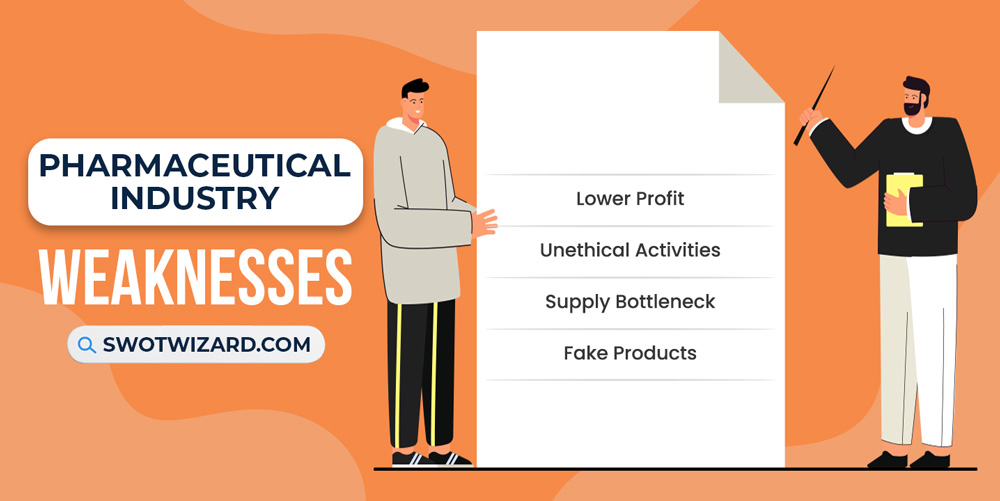
Lower Profit: The pharma industry’s revenue is known to be high, and so should the profit margin. But, as the day goes by, the profit margin narrows as the raw material cost continuously rises. As a result, for the new companies, it is challenging to survive in the market with an unhealthy cash flow and narrow margin.
Unethical Activities: The competition in the pharma industry is cutthroat. The giants are trying to capture even the smallest portion of the market, and it is getting tougher and more challenging to compete and keep up with the giant competitors, and the big companies’ unethical activities toward doctors and other personnel are well known to all.
Supply Bottleneck: As the competition rises, the industry faces a vast supply chain problem. The demand and supply curve is going downward, and the price is increasing because of the high demand and short supply. As a result, a few suppliers are taking advantage of the situation, and the entire industry is facing issues because of that.
Fake Products: Counterfeit products in the pharma industry have always been a significant problem, and no matter how much effort the companies put into ending this, that’s never been enough. Not only are those products a massive problem for patients and customers, but also negatively impact the overall industry image.
Opportunities – Pharmaceutical Industry SWOT Analysis

More Lucrative Markets: The health issues are not going anywhere, and the patients are. As sad as it might sound, new diseases helped us develop more advanced medicines, and there are always new drugs to develop in new continents to cure those problems. Besides, developing more advanced medicines for existing health issues has always been a good practice.
Tech Implementation: Technology has been a blessing and an excellent addition to developing more effective and efficient medicines. It saves a ton of lives, as well as easier the pain for millions of patients. As a result, we can see the advanced treatment for major diseases, cancers, kidney disorders and etc.
Government Subsidy: The countries’ governments have always shown friendliness to the pharma sectors to develop and invest more. As a result, we can see the investment has grown significantly, as well as helping giant companies to set up factories in developed and developing countries to build a positive brand image.
More Awareness: The medicines are still a mystery to millions of people. As the drugs and treatments are getting expensive, healthcare is still out of hand for most people, and awareness level is getting lower. The industry has the opportunity to help people get to know better about medicines, fake medicines and other issues through PR campaigns.
Threats – Pharmaceutical Industry SWOT Analysis
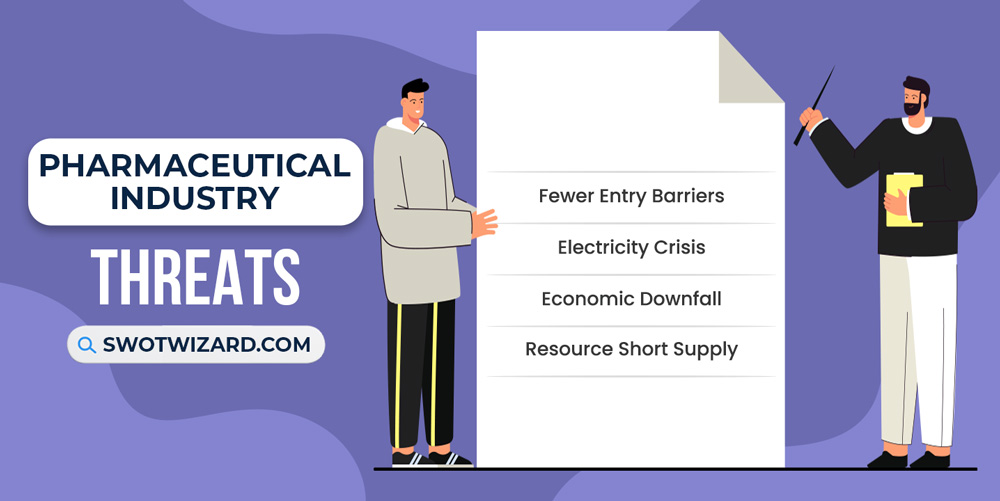
Fewer Entry Barriers: The competition in this industry might be challenging, but the entry barriers aren’t. That single factor alone created many issues in the entire industry, such as supply chain disruption, raw material shortage, fake products, etc. These issues were getting bigger every day and became a massive threat for the industry to regulate.
Electricity Crisis: One significant reason for the rising cost of medicines is the electricity crisis. Companies and manufacturers consume so much energy that they have to increase the price as the electricity bill increases. In 2023, the price and manufacturing cost might rise from 25% to 36% and maybe more, and it will affect the entire industry significantly, which has become a massive issue.
Economic Downfall: The recession is part of the world economy and considerably impacted the pharma industry every time it hit the roof. In the 2008 recession, the companies had to lay off an average of 15% to 30% of their workforce. As the trend has started, we might face another similar event in the 2023-2024 timeline.
Resource Short Supply: The pharma industry is going through a substantial short supply in every sector. As a result, it significantly delayed the overall operations of many companies, and the development of new medicines is also getting delayed. It is hampering the overall industry and causing the companies’ money, time and energy.
[Bonus Infographic] SWOT Analysis of Pharmaceutical Industry
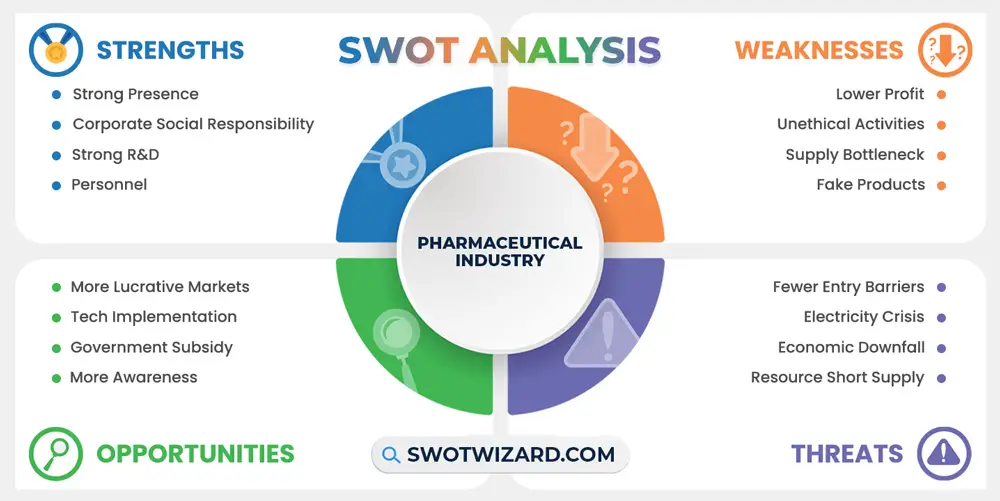
Recommendations for Pharmaceutical Industry
As the industry grows, new problems emerge with every innovation and new world system. Here are some recommendations for the companies to grow the sector even more and survive in the space.
- One of the significant issues is fake or counterfeit products, and all companies and governments should take actions to prevent this collectively for the greater good.
- There should be healthy regulations by the authority boards to regulate the companies and unethical activities.
- The awareness of the industry will grow a positive and clear image in the customers’ minds.
- Companies in the industry should integrate more with emerging technologies to make the products more effective and efficient.
Frequently Asked Questions (FAQs)
Which Country is No 1 in the Pharma Industry?
Germany is No 2 in the pharma industry.
What is the Largest Pharmaceutical Company In Asia?
Kalbe Farma is the largest pharmaceutical company in Asia.
Final Words on Pharmaceutical Industry SWOT Analysis
The pharmaceutical industry has grown into one of the world’s largest industries because of its essentiality. Besides, a strong global presence and heavy investment in R&D have made this industry grow fast. But some new and old issues have been causing problems for the companies in this industry and slowing down their growth. But, the industry will overcome these issues and stay at the top with their functionality and relevancy.
References
- Pharmaceuticals – Worldwide. (n.d.). Statista.
- Business Bliss Consultants FZE. (2018, November). Positive Impact of CSR on the Pharmaceutical Industry.
- Assis, P. (2022, June). Pharmaceutical R&D spending trends in 2022. PreScouter.
- Mikulic, M. (2023, February 3). 2023 ranking of the global top 10 biotech and pharmaceutical companies based on employee number. Statista.
- Raw material prices affect margins of pharma drugs. (2022, September 26). Express Pharma.
- Garattini, L., & Padula, A. (2018). Competition in pharmaceuticals: more product- than price-oriented? European Journal of Health Economics.
- De Kondserovsky, S., Abecassis, M., & De Galembert, M. (2022, May 24). Raw material shortage and its impact on the pharma industry. DLA PIPER.
- Balfour, H. (2022, May 3). The latest on pharmaceutical counterfeiting. European Pharmaceutical Review.
- Huang, Z., Lan, Y., & Zha, X. (2022). Research on government subsidy strategies for new drug R&D considering spillover effects. PLOS ONE, 17(2), e0262655.
- Mole, B. (2023, February 1). US still has the worst, most expensive health care of any high-income country. Ars Technica.
- Stewart, A. (2023, January 10). Winter is Coming: How the Energy Crisis Will Change Pharma in 2023. The Medicine Maker.
- Shukar, S., Zahoor, F., Hayat, K., Saeed, A., Fang, Y., Omer, S., Hu, S., Babar, Z., & Yang, C. (2021). Drug Shortage: Causes, Impact, and Mitigation Strategies. Frontiers in Pharmacology, 12.

